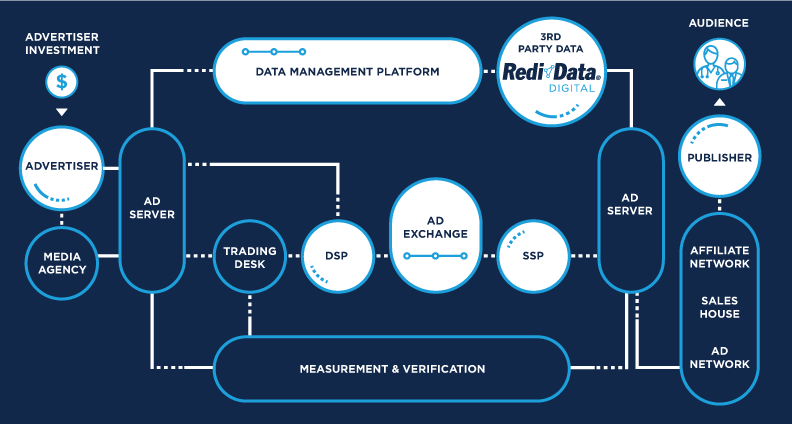Programmatic advertising has become a key tactic for marketers who want to target specific audiences with digital ads using precision and scale. Marketers use programmatic advertising to automate ad placement and optimize delivery in real time. According to eMarketer, about 86.5% of digital display ad dollars are now spent on programmatic buying, meaning advertisers increasingly rely on automation for efficiency and accuracy.
As medical brands look for new solutions to enrich their advertising strategies and healthcare lists, more marketers turn to programmatic advertising to reach their audiences across multiple platforms. Programmatic advertising connects brands to audiences by analyzing behavioral and demographic data. However, the programmatic digital media supply chain involves multiple intermediaries and can become complex and confusing without a clear understanding of its structure.
This guide breaks down programmatic advertising into what it is, how it works, and why audience data plays such an important role. By the end, you will understand how programmatic advertising functions and how it can help expand your marketing reach.
An Introduction to Programmatic Advertising – What Is It?
Programmatic advertising is an automated system designed for buying and selling digital ads through a real-time bidding (RTB) process. Programmatic technology replaces manual methods like RFPs, negotiations, and insertion orders with algorithmic automation. The system enables marketers to deliver the right message to the right audience at the right time and place using data-driven signals.
Programmatic advertising allows targeting that creates more personalized, one-on-one ad experiences than traditional media buying. Each ad is tailored to user interests, demographics, or behavioral data, enabling brands to engage audiences across their preferred channels. Programmatic ads appear across mobile, video, connected TV (CTV), and social media, allowing marketers to reach audiences anytime and anywhere.
Programmatic systems integrate data, algorithms, and ad exchanges to create dynamic ad placements that align with audience intent.
How Does Programmatic Advertising Work?
The programmatic advertising ecosystem consists of two main sides: the Supply Side (publishers who sell ad inventory) and the Demand Side (advertisers who buy it). Publishers and advertisers interact within an ad exchange, a digital marketplace that matches available ad space with advertiser bids.
Before the exchange process begins, publishers use a Supply-Side Platform (SSP) to list their available inventory securely. Advertisers use a Demand-Side Platform (DSP) to upload and store their creative assets and bidding parameters. The ad exchange acts as the intermediary that facilitates transactions between SSPs and DSPs.
Auction-Based Bidding
Most brands purchase ad inventory using real-time bidding (RTB), a process that enables publishers to make their ad space available to all buyers within an ad exchange. In an RTB auction, each advertiser submits a CPM (cost per thousand impressions) based on their perceived value of the inventory. The highest bidder wins the auction, and their ad is displayed to the target audience.
Some RTB transactions occur in Private Marketplaces (PMPs), where publishers invite selected advertisers to bid on premium inventory. PMPs provide more control, transparency, and brand safety for advertisers.
Alternatively, Programmatic Direct deals allow a publisher and advertiser to negotiate directly without an auction. In this case, the price is fixed at a premium CPM, and the publisher can sell multiple inventory types while maintaining performance visibility. Programmatic Direct ensures predictable delivery and brand alignment, making it ideal for healthcare and enterprise campaigns.
Why Does Audience Data Play Such an Important Role?
Audience data is the foundation of programmatic advertising strategy, enabling marketers to reach high-value audiences with accuracy. Marketers use audience data to inform bidding, targeting, and creative personalization decisions.
Typically, marketers use first-party data — the information collected directly from customers — to identify who they want to reach. First-party data represents the most accurate view of an audience because it reflects real interactions and preferences.
To expand reach, marketers often integrate third-party data provided by data partners. Third-party data includes probabilistic and deterministic datasets that model audience segments and enhance targeting precision.
Probabilistic data groups audiences based on shared characteristics, behaviors, or inferred interests, allowing advertisers to find users who resemble their existing customers. Probabilistic data is valuable for broad reach and lookalike modeling.
Deterministic data, by contrast, relies on unique identifiers such as email addresses, phone numbers, or user IDs that directly link to specific individuals. Deterministic data verifies identity and ensures one-to-one targeting accuracy.
In healthcare marketing, deterministic data is particularly powerful. Healthcare marketers use deterministic data to target specific healthcare providers (HCPs) based on credentials such as NPI numbers. Redi-Data Digital enables marketers to reach HCPs at scale with unmatched precision. Redi-Data combines deterministic and probabilistic datasets to deliver customized HCP audience segments, improving engagement and outperforming traditional marketing efforts.
Once the advertiser wins a bid and defines the target audience, the publisher reserves the ad space and launches the campaign. Marketers then monitor metrics such as viewability, CTR, and KPIs to evaluate effectiveness and verify whether campaigns are reaching the intended audience. Data measurement and optimization close the feedback loop, ensuring continuous improvement in performance.
Conclusion
Now that we have explained the what, how, and why of programmatic advertising, you are ready to explore how automation, data, and AI-driven targeting can transform your digital marketing strategy.
To get started, check out our Programmatic Glossary for key terms that simplify the complex programmatic landscape.
Want to learn more about boosting your data strategy with third-party data? Our Redi-Data specialists can help you integrate programmatic advertising with audience data to maximize reach and performance — contact us today to get started.
Better Data, Better Outcomes.
Source:
1 – eMarketer US Programmatic Report Part 2 May 2020_Final.pdf

